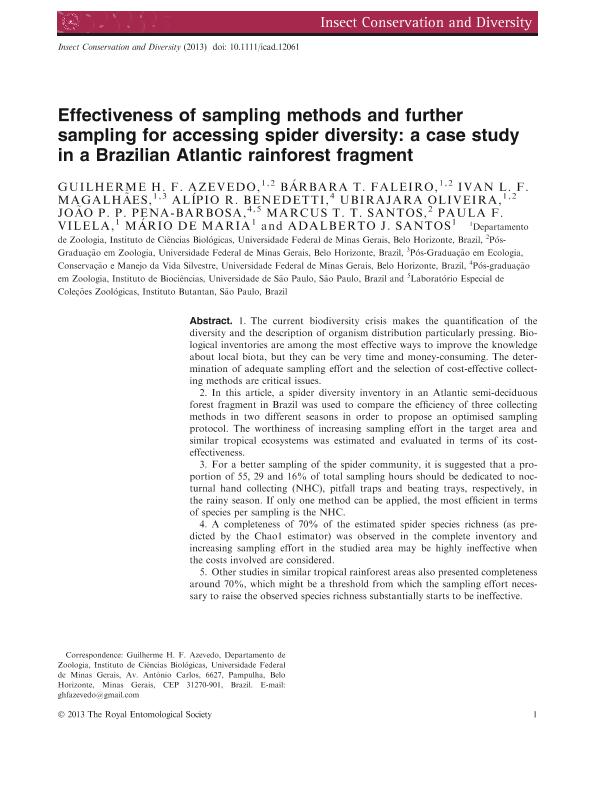Artículo
Effectiveness of sampling methods and further sampling for accessing spider diversity: A case study in a Brazilian Atlantic rainforest fragment
Azevedo, Guilherme H. F.; Faleiro, Bárbara T.; Fiorini de Magalhaes, Ivan Luiz ; Benedetti, Alípio R.; Oliveira, Ubirajara; Pena Barbosa, João P. P.; Santos, Marcus T. T.; Vilela, Paula F.; de Maria, Mário; Santos, Adalberto J.
; Benedetti, Alípio R.; Oliveira, Ubirajara; Pena Barbosa, João P. P.; Santos, Marcus T. T.; Vilela, Paula F.; de Maria, Mário; Santos, Adalberto J.
 ; Benedetti, Alípio R.; Oliveira, Ubirajara; Pena Barbosa, João P. P.; Santos, Marcus T. T.; Vilela, Paula F.; de Maria, Mário; Santos, Adalberto J.
; Benedetti, Alípio R.; Oliveira, Ubirajara; Pena Barbosa, João P. P.; Santos, Marcus T. T.; Vilela, Paula F.; de Maria, Mário; Santos, Adalberto J.
Fecha de publicación:
07/2014
Editorial:
Wiley-liss, Div John Wiley & Sons Inc
Revista:
Insect Conservation And Diversity
ISSN:
1752-458X
Idioma:
Inglés
Tipo de recurso:
Artículo publicado
Clasificación temática:
Resumen
The current biodiversity crisis makes the quantification of the diversity and the description of organism distribution particularly pressing. Biological inventories are among the most effective ways to improve the knowledge about local biota, but they can be very time and money-consuming. The determination of adequate sampling effort and the selection of cost-effective collecting methods are critical issues. In this article, a spider diversity inventory in an Atlantic semi-deciduous forest fragment in Brazil was used to compare the efficiency of three collecting methods in two different seasons in order to propose an optimised sampling protocol. The worthiness of increasing sampling effort in the target area and similar tropical ecosystems was estimated and evaluated in terms of its cost-effectiveness. For a better sampling of the spider community, it is suggested that a proportion of 55, 29 and 16% of total sampling hours should be dedicated to nocturnal hand collecting (NHC), pitfall traps and beating trays, respectively, in the rainy season. If only one method can be applied, the most efficient in terms of species per sampling is the NHC. A completeness of 70% of the estimated spider species richness (as predicted by the Chao1 estimator) was observed in the complete inventory and increasing sampling effort in the studied area may be highly ineffective when the costs involved are considered. Other studies in similar tropical rainforest areas also presented completeness around 70%, which might be a threshold from which the sampling effort necessary to raise the observed species richness substantially starts to be ineffective.
Archivos asociados
Licencia
Identificadores
Colecciones
Articulos(MACNBR)
Articulos de MUSEO ARG.DE CS.NAT "BERNARDINO RIVADAVIA"
Articulos de MUSEO ARG.DE CS.NAT "BERNARDINO RIVADAVIA"
Citación
Azevedo, Guilherme H. F.; Faleiro, Bárbara T.; Fiorini de Magalhaes, Ivan Luiz; Benedetti, Alípio R.; Oliveira, Ubirajara; et al.; Effectiveness of sampling methods and further sampling for accessing spider diversity: A case study in a Brazilian Atlantic rainforest fragment; Wiley-liss, Div John Wiley & Sons Inc; Insect Conservation And Diversity; 7; 4; 7-2014; 381-391
Compartir
Altmétricas



